The Fortifications of Vauban consists of twelve groups of fortified buildings along the borders of France. The fortifications were designed by Sébastien Le Prestre de Vauban, the chief military engineer of King Louis XIV. Vauban designed and built fortified towns, citadels, urban bastions, walls and bastion towers. Vauban also built sea forts and mountain forts. Vauban also improved several other fortifications in France and other countries, such as the casemates of the city of Luxembourg during the French occupation in the 17th century. Vauban played an important role in the history of fortification in Europe and other continents. The fortifications of Vauban were copied and used in the Western military architecture until the mid-19th century. Vauban was the most important military engineer the 17th century. The Citadel of Longwy was built to protect invasion routes into France from the Ardennes. The Citadel of Longwy became a key defence post opposite the impressive fortresses of Luxembourg, at that time in Spanish hands. The Fortifications of Vauban gained the status as a UNESCO World Heritage in 2008.
www.werelderfgoedfotos.nl © Copyright World Heritage Photos
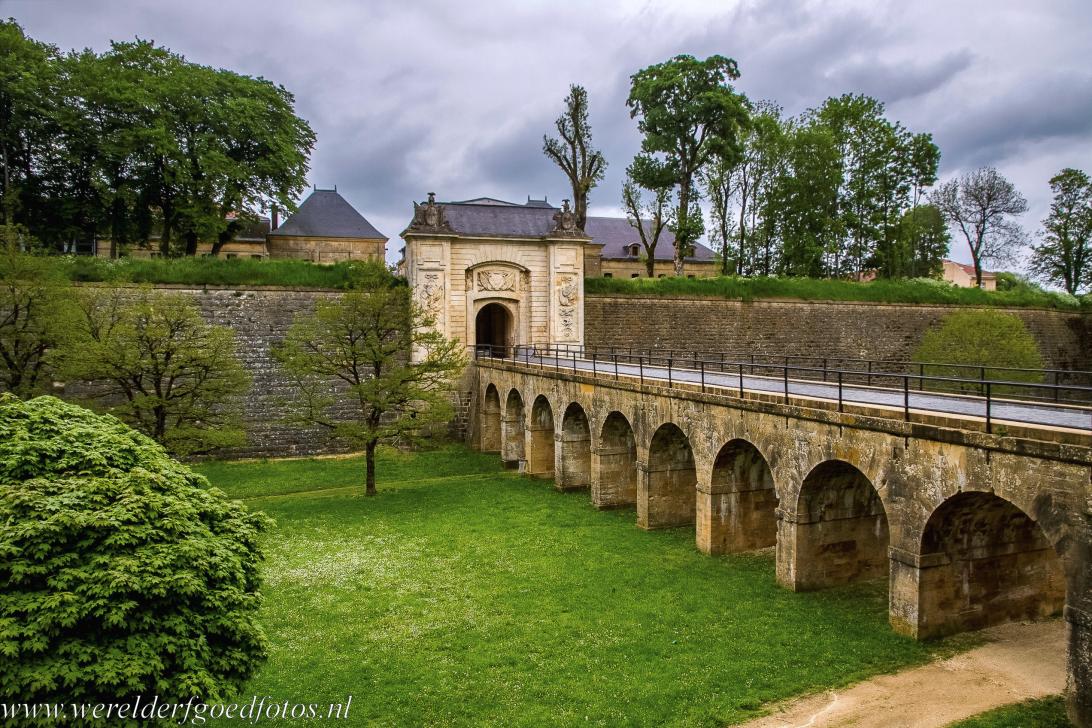
Fortifications of Vauban: The Porte de France, the Gateway of France, is the main gate into the Citadel of Longwy. The fortifications were designed by the military engineer Sébastien Le Prestre de Vauban. He designed bastion towers, citadels, fortified towns, mountain and sea forts, urban bastions and walls, he also improved several fortifications in France and other countries. Twelve Fortifications of Vauban were declared a UNESCO World Heritage in 2008. These twelve are the most impressive of all the fortifications built by Vauban in France.

Fortifications of Vauban: The Porte de France, the Gateway of France, is the main gate into the Citadel of Longwy. The fortifications were designed by the military engineer Sébastien Le Prestre de Vauban. He designed bastion towers, citadels, fortified towns, mountain and sea forts, urban bastions and walls, he also improved several fortifications in France and other countries. Twelve Fortifications of Vauban were declared a UNESCO World Heritage in 2008. These twelve are the most impressive of all the fortifications built by Vauban in France.
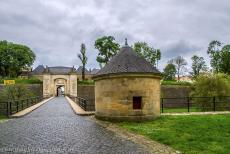
Fortifications of Vauban: The Porte de France, the Gateway of France, of the Citadel of Longwy. The fortifications were partly destroyed during World War I, but four bastions, a water well, the military bakery, the Porte de France and parts of the walls have been preserved. The other gate of Longwy, Porte de Bourgogne, was destroyed during World War I. The fortifications of Vauban were copied and used in Western military architecture until the middle of the 19th century. The military bakery is now a museum of enamels and earthenware, produced in Longwy.
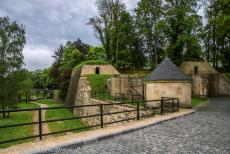
Fortifications of Vauban: The Citadel of Longwy passed in and out of French hands throughout the 17th century. In 1679, by the Treaties of Nijmegen between the Republic of the Seven United Netherlands and France, Longwy became French. The French King Louis XIV, also called the Sun King, ordered his military engineer Sébastien Vauban to build a new fortified city in Longwy. The city became a key defence post opposite the impressive fortresses of Luxembourg, at that time in Spanish hands. The Citadel of Longwy was built at a strategic location on a mountain plateau.
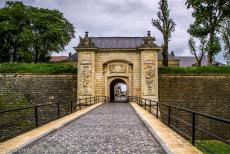
Fortifications of Vauban: The Porte de France into the Citadel of Longwy. Twelve Fortifications of Vauban are listed as a UNESCO World Heritage, seven of them: Longwy, Ville Neuve, the citadel; Mont-Dauphin, Place Forte (stronghold); Mont-Louis, the citadel and city walls; Neuf-Brisach, the citadel, gateway of the Rhine; Saint-Martin-de-Ré, city walls and citadel; Saint-Vaast-la-Hougue / Tatihou, the watchtowers; Villefranche-de-Conflent, the city walls, Fort Libéria and Cova Bastera, a fortified grotto. The fortifications of Vauban were designed and built between 1667 and 1707.
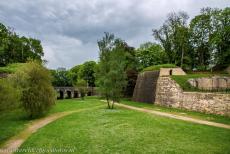
Fortifications of Vauban: The broad and deep dry moat of the Citadel of Longwy, the Ville Veuve. Longwy is situated in the northeast of France, on the border with Belgium and Luxembourg. The Citadel of Longwy is hexagonal in shape, it has a perimeter of 2,300 metres, the citadel had two gates. The fortifications of Longwy endured four sieges, the last one in 1914 at the beginning of World War One, also known as the Great War. During the war, one of the gates was completely destroyed in 1914. Today, only half of the surrounding walls remain.
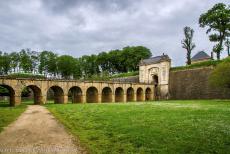
Fortifications of Vauban: The dry moat and the access bridge to the Porte de France, the French Gate, the 17th century gate is the main entrance into the Citadel of Longwy. The Fortifications of Vauban are a series of fortified cities and buildings along the borders of France. Longwy is one of the cities that was built by the chief military engineer of the French King Louis XIV, Sébastien Le Prestre de Vauban. He was the most important military engineer of his time, he also built the casemates of the City of Luxembourg during the French occupation in the 17th century.
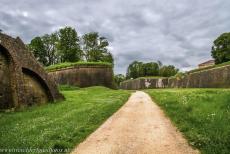
Fortifications of Vauban: The Citadel of Longwy. Twelve Fortifications of Vauban are listed as a UNESCO World Heritage, five of them are: Arras, the citadel; Besançon, the citadel, city walls and Fort Griffon; Blaye, the citadel, city walls, Fort Paté, Fort Médoc in Cussac-Fort-Médoc; Briançon, the walls, Redoute des Salettes, Fort Dauphin, Fort des Trois-Têtes, Fort du Randouillet, ouvrage de la communication Y and Asfeld Bridge; Camaret-sur-Mer, the Tour Dorée and Tour Vauban. The fortifications of Vauban were built to protect the borders of France from invaders.
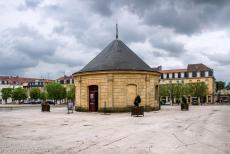
Fortifications of Vauban: The bombproof siege well in the Citadel of Longwy stands in the main square. Now, the building houses a Tourist Office. Longwy was built according to a geometric plan, like a chess-board. The principal north-south axis is leading to the main square of Longwy. This square, the Place Darche, was the parade ground and the assembly point for the soldiers. Twelve Fortifications of Vauban, including the Citadel of Longwy, were inscribed on the UNESCO World Heritage List in 2008.
